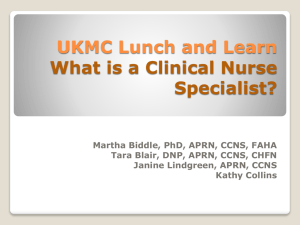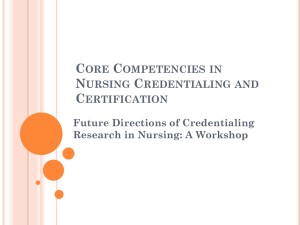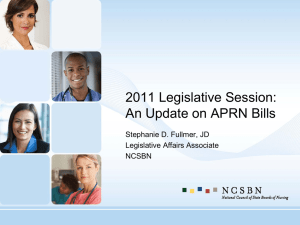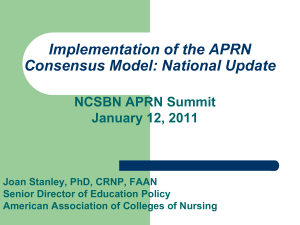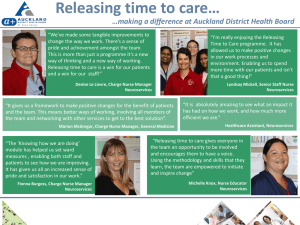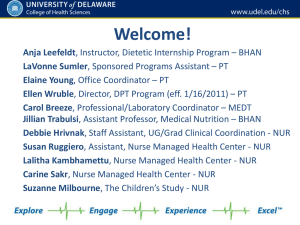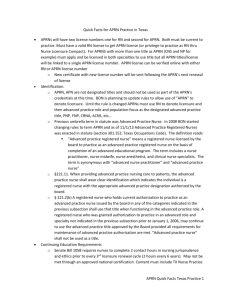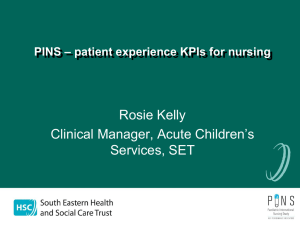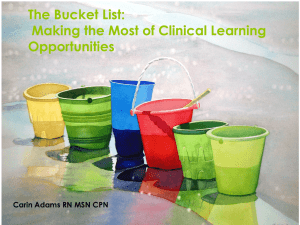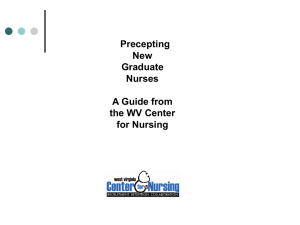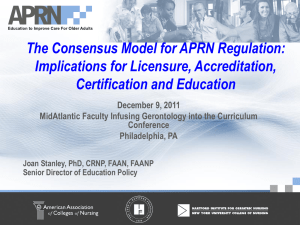APRN Primary Care Workforce Data, Trends, and Issues
advertisement
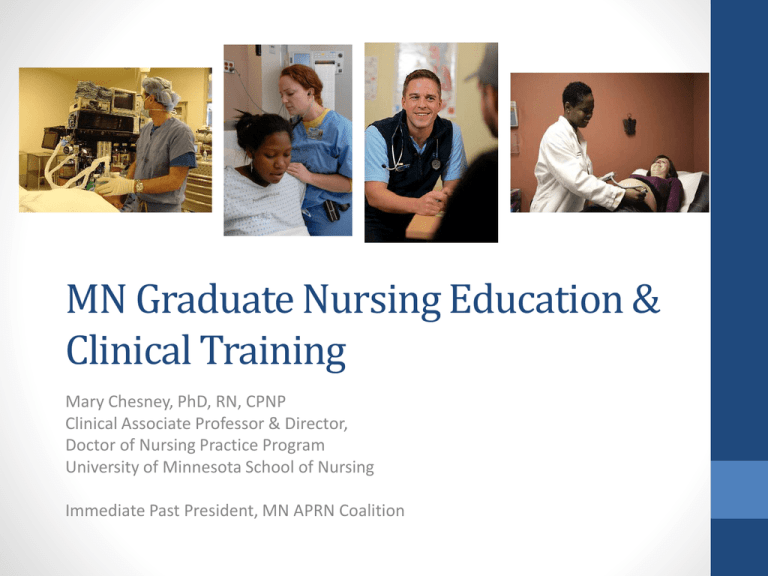
MN Graduate Nursing Education & Clinical Training Mary Chesney, PhD, RN, CPNP Clinical Associate Professor & Director, Doctor of Nursing Practice Program University of Minnesota School of Nursing Immediate Past President, MN APRN Coalition Presentation’s Definition of GNE • GNE = graduate nursing education in the generic sense & doesn’t relate to a formal funding mechanism • Differentiated from GME (Graduate Medical Education) – a formal Medicare-sponsored funding mechanism for graduate medical education • NOTE: ACA mandated pilot GNE funding grant • 5 U.S. Hospitals (and affiliated APRN programs) • First time in 47 years Medicare is supporting APRN education GNE Categories by Nurse Role • Traditional Advanced Practice Registered Nurse (APRN) • • • • Clinical Nurse Specialists (CNSs) Nurse Midwives (NMs) Nurse Practitioners (NPs) Registered Nurse Anesthetists (RNAs) • Programs other than APRN • • • • • Nursing administration/leadership Nursing Education Informatics Public Health Integrated Health & Healing GNE Categories by Degree • GNE continues to evolve; moving from Master’s to Doctoral degree preparation • Prerequisite for admission to either degree is a minimum of a bachelor’s degree in nursing • Master’s Degree • 2 years • Doctor of Nursing Practice (DNP) Degree • Initiated in 2006 • 3 to 4 years (about 8 -9 semesters) APRN Acronym Key • • • • • • • • • A/GNP A/GCNS FNP RNA NM PCNS PMHNP PNP WHNP Adult/Gerontology Nurse Practitioner Adult/Gerontology Clinical Nurse Specialist Family Nurse Practitioner Registered Nurse Anesthetist Nurse Midwife Pediatric Clinical Nurse Specialist Psych-Mental Health Nurse Practitioner Pediatric Nurse Practitioner Women’s Health Nurse Practitioner Minnesota’s Graduate APRN Programs 1. Augsburg – FNP (DNP degree) 2. Bethel – NM (MS degree) 3. College of St. Scholastica – ACNS, A/GNP, FNP, PMHNP (DNP degree) 4. Mayo School of Health Sciences – RNA (MNAP DNAP) 5. Metropolitan State University – FNP (DNP degree) 6. Minneapolis School of Anesthesia/St. Mary’s U – RNA (MS) 7. MN State University-Mankato – FNP (MS degree) 8. St. Catherine University – A/GNP, PNP (MS degree); option to earn DNP degree) 9. University of MN – A/GNP, FNP, PNP, PMHNP, WHNP; RNA, NM, A/GCNS, PCNS (DNP degree) 10. Winona State University – A/GNP, Acute A/GNP, FNP (MS degree; option to earn DNP degree) MN’s Graduate Primary Care APRN Programs MN School A/GNP Augsburg College FNP PNP WHNP X Bethel University College of St. Scholastica NM X X X Metropolitan State University X Minnesota State University - Mankato X St. Catherine University X University of Minnesota X X Winona State University X X X X X X MN’s Graduate Acute Care/MH APRN Programs MN School Acute Care A/GNP College of St. Scholastica A/G CNS Nurse Anesthesia X X Minneapolis School of Anesthesia (St. Mary’s) X University of Minnesota X X X Psych MH NP X Mayo School of Health Sciences Winona State University Peds CNS X X X MN’s Other Graduate Nursing Programs MN School Admin/ Leader Ed Integrative Informatics Public TransHealth Health Cultural Nsg. Augsburg College Bethel University X X X MN State U Mankato X St. Catherine University X University of Minnesota X Winona State University X X X X *Certificate (non-degree) Program X MN’s Primary Care APRN Grads 2012-13 School A/GNP FNP NM PNP WHNP Total Augsburg (15/yr) - New 2013 - - - 0 Mankato - 34 - - - 34 Metro St - 24 - - - 24 St. Catherine 99* St. Scholastica 16 27 - - - 43 U of MN 9 16 6 5 8 44 Winona 2 10 - - - 12 Totals 256 APRN Requirements for Practice State APRN Licensure (As of January, 2015) Role & Pop Focused Clinical Training Hrs = 500 to 1,000+ National Board Certification in Role & Specific Population Focus Graduate Nursing Education – Master’s or DNP Degree Registered Nurse License Clinical Practice as an RN Minimum of Bachelor’s Degree in Nursing 4 yrs. BSN + 2-3 yrs. MS/DNP = 6+ Years of Academic & Clinical Preparation BSN Clinical Training Hrs = Min. 500+ APRN Clinical Hours • Determined by a number of entities • Accrediting bodies • Certification bodies • American Association of Colleges of Nursing • National Task Force (NP) • Competency-based components may extend clinical hours • MN Schools • Master’s programs - minimum of 500 hours (MN avg. of 600 hours) 1:1 preceptor-supervised, role and population-focused direct provider clinical hours • DNP programs - minimum 1,000 hours • About 650 to 800+ hours of 1:1 preceptor-supervised, role and population-focused direct provider clinical hours • 200 to 400+ hours of systems-focused clinical hours (QI projects, IPECP leadership initiatives) U.S. & MN APRN Data MN August 2014 U.S. 2014 APRN Role # in U.S. APRN Role # in MN CNSs 70,000 CNSs 554 NMs 13,071 NMs 287 NPs 192,000 NPs 3,969 RNAs 39,000 RNAs 1,647 TOTAL 314,071 TOTAL 6,457 GNE APRN Clinical Training • Clinical training days are integrated into didactic education • Students are assigned to a specific clinical site and preceptor (MD or APRN) for a semester • RNA student is assigned to surgery department & works with a CRNA or MDA • NP student is assigned to an NP or MD/DO at an urban, suburban, or rural clinic) • NM student assigned to NM and practices both in clinic setting and in birthing center or hospital L & D • CNS student assigned to CNS in hospital unit • Variety of rotations planned across time to expose students to racial/ethnic/SES/geographic diversity • Typical full-time student APRN school week: • 36 to 40 hours of didactic course work (courses plus homework) • 16 hours (two 8-hour days) clinical training GNE APRN Clinical Training • Other than limited MERC funding to qualifying clinical sites, there isn’t a funding mechanism for APRN clinical training • Preceptors and clinical facilities precept APRN students on a volunteer basis (exception – emergence of preceptor payments from out-of-town online NP programs) • CMS oversight and charting requirements that limit provider productivity cause reluctance to precept APRN students • Requirements are more onerous for staff working with APRN or medical students than those working with residents who are already licensed Clinical Training Sites • Urban, suburban, rural out-patient clinics (pediatric, internal medicine, family practice, women’s health, OB-Gyn) • Urgent care & retail clinics • Urban, suburban, and rural hospitals (surgical suites, L & D, patient-care units, ED) • Ambulatory surgery centers • Transitional care units, long-term care facilities, and home care agencies APRN Student Numbers & Sites Needed • U of MN utilizes over 250 clinical sites per semester • 180 NP primary care, LTC, or TCU sites • 16-20 CNS in-patient sites • 10-14 NM sites (clinics and L & D or birth center sites) • 36 NA sites Estimate of MN Needed APRN Sites per Semester • Psych-MH NP sites = 40 to 50 per semester • Primary Care NP sites needed per semester = 400 to 450 per semester • Biggest demands • FNP sites = 235 to 245 per semester (6 FNP programs in MN) • A/GNP sites = 130 to 140 per semester (3 A/GNP programs in MN) • Numerous out-of-state online FNP programs add to these numbers • Nurse midwife sites = 50 per semester • Nurse anesthesia sites = 160 to 165 per semester • Clinical nurse specialist sites = 50 to 60 per semester TOTAL APRN Clinical Training Sites per Semester = 700 to 775* (* Missing Winona State’s Acute-Care A/GNP numbers) Challenges & Issues • No federal funding mechanism for clinical training of APRNs • Onerous CMS regulations for medical and APRN students result in decreased productivity & revenue in current fee-forservice reimbursement structure • Proprietary out-of-state online schools are starting to pay for preceptors/sites; many implications to consider • Increasing Twin Cities & Rochester competition for primary care sites (Med, PA, APRN) Challenges & Issues • Placing & supporting APRN clinical students in greater MN is currently challenging • As of 2013, there are 28 unfilled faculty vacancies in Minnesota (American Association of Colleges of Nursing, 2014) • Faculty shortages continue to rise; majority of today’s nursing faculty members will retire within the next 10-15 years; we do not have adequate DNP or PhD degree nurses in the pipeline • Nursing faculty salaries are not competitive with practice salaries; disincentive to teach Challenges & Issues APRN workforce doesn’t represent MN’s racial/ethnic diversity Working to recruit students of color; best demographic representation in nursing currently resides in A.D. nursing programs Race or Ethnicity Minnesota (2013)* MN APRNs (2011-12)** American Indian 1.3% 0.4% Black or African American 5.7% 1.7% Asian 4.5% 1.8% Multiple Races 2.3% 1.2% Other 0.1% 0.8% White or Caucasian 86.2% 94% Hispanic or Latino 5.0% 0.8% *Data from 2013 U.S. Census **Data from MDH ORHPC 2011-12
